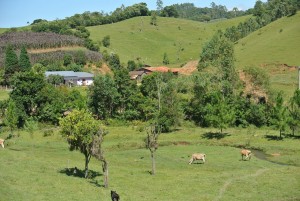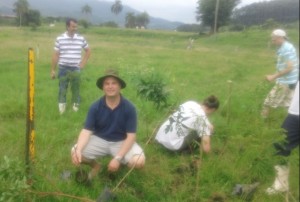By: Juan P. Alvez | Pasture Technical Coordinator at the UVM Center for Sustainable Agriculture
Early this year, my work in sustainable agriculture brought me to the State of Santa Catarina (Southern Brazil), as a co-instructor of “Agroecology, Ecosystem Services and Farmer’s Livelihoods”. There, I joined about twenty people, visiting farms located at the Atlantic Forest, on a 9-day applied field course and workshop. The event was hosted by Universities of Vermont and Universidade Federal de Santa Catarina.
Santa Catarina and Vermont share many similarities, including topography, size and identity with rural living and family farms. On the other hand, Santa Catarina State has subtropical humid climate and the level of deforestation reaches over 88%. Also, the Atlantic forest is considered a biodiversity hotspot, harboring more species per hectare than NE U.S.
While formerly, most farmers planted tobacco, eucalyptus and other high input crops, currently they still face the challenges of farming in very steep terrains and providing for their families. Soil erosion, nutrient runoff and water quality were a rampant problem.
However, the main challenge is to meet the requirements set by the Brazilian Forest Act. Currently most of these farmers and specially the smallest ones, are occupying areas of permanent preservation such as hilltops, riparian areas and water sources thus, clearly infringing environmental laws.
This workshop aimed to contribute to a long-term search for creative solutions that can help promote conservation, restore the Atlantic Forest, preserving its rich biodiversity and sustaining rural livelihoods through agroecological practices.
We visited the town of Santa Rosa De Lima, –also known as the “agro-ecology capital of Brazil”-, to study silvopastoral systems with high-levels of native biodiversity. The focus was on how different agroecological practices can support conservation efforts in Santa Catarina. Specifically, we wanted to investigate how combining new forest patches with management-intensive grazing (MIG) can be one of the approaches to address deforestation, improving dairy production and keeping families in their farms.
Previously, it has been found that farmers who switched to MIG observed improvements in environmental and production variables with increases in pasture productivity, with 55% reporting a slight increase in pasture area without deforesting new areas. A larger herd size was achieved in 63% of the farms surveyed. Daily total milk production and productivity per animal increased by 80% and 73%, respectively.
Improvements in soil cover, soil quality, and soil moisture were reported in 87%, 95%, and 80% of surveyed farms. Producers also perceived a stabilization and reduction of erosion gullies; electric fencing restricted animal access to rivers, which decreased in 59% of farms, while riparian buffers increased in 22% of the properties. Thus, perceived water quality improved for 29% of interviewees.
Ticks diminished in 73% of the farms, mastitis in 80%, intestinal worms in 67%. Pesticide use dropped in 60% of farms and TMR fed to animals decreased in 49% of the farms.

From left to right: Bertilo (Ag. Service Provider), Abdon Schmitt and Joshua Farley (Faculty), Skyler Perkins (Student)
Manure accumulation in the milk parlor dropped in 53%, and workload fell from 8 to 4 hours per day in 66% of the farms respectively. Consequently, 67% of the farms reported better quality of life. Lastly, economic return was optimal or within expectations for 67% of farmers and production costs fell according to 34% of interviewees.
This long-term collaboration has ties to Vermont, with inspirations that can be tracked two decades ago, influenced by Bill Murphy (Professor Emeritus of UVM, PSS). The on-going collaboration includes three University of Vermont institutions, the Gund Institute for Ecological Economics, the Center for Sustainable Agriculture, the Department of Community Development and Applied Economics, and students and researchers from two Brazilian Universities (Universidade Federal de Santa Catarina and Universidade de Sao Paulo).




Recent Comments